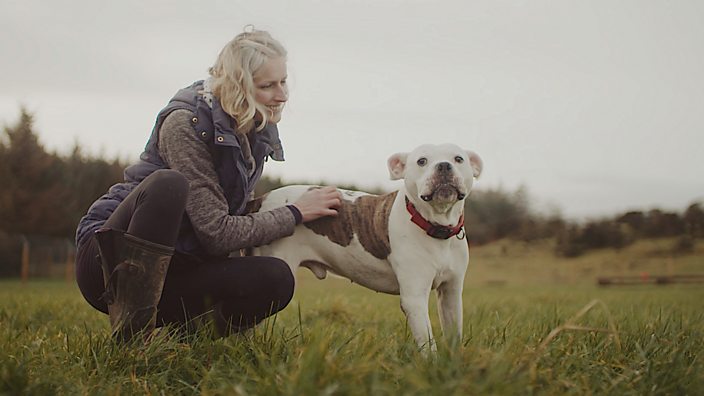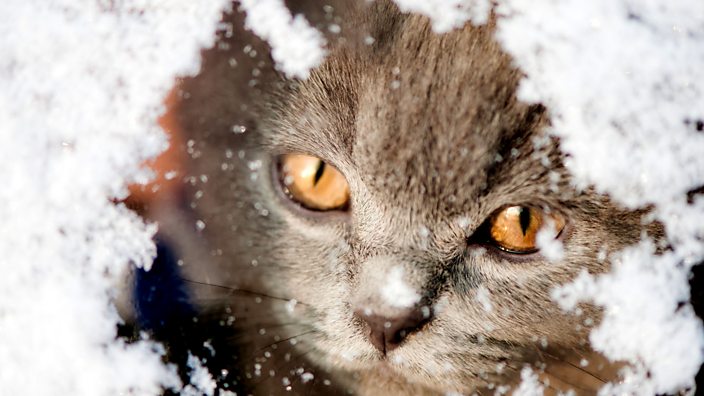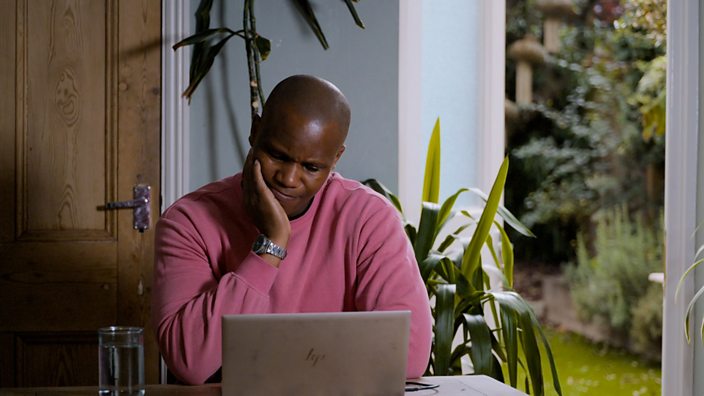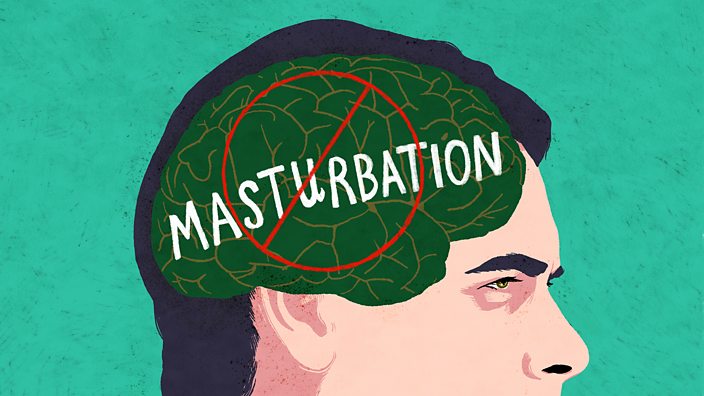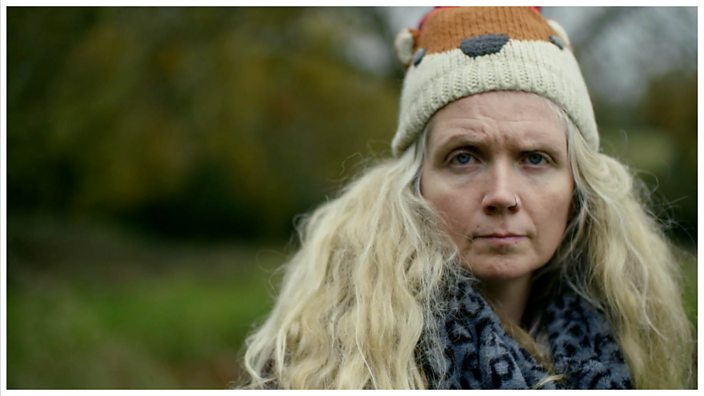 BBC Three
BBC ThreeKnocked out, punched, and charged by horses: the life of a hunt saboteur
Cathy Scott spends her spare time trying to show why she thinks the hunting ban isn’t working
“I’ve been knocked out. I’ve had a broken nose. I was punched in the face. I got a fractured cheek. I’ve been hit on the head with bottles. I’ve been attacked a lot.”
Cathy Scott has experienced the kind of injuries you might associate with a cage fighter. They have all been inflicted by men or animals. Three times a week she heads for the countryside to follow the riders and hounds of various hunts in order to film what she believes is illegal activity, handing over the footage to the police. Sometimes they manage to save a fox. Sometimes they get charged by horses.
“I’ve been ridden into quite a few times. And it hurts,” she says.
Cathy, 42, has been ‘sabbing’ – or sabotaging hunts – with two to three associates at a time since the Hunting Act came into force to make fox hunting with dogs illegal in 2005. Attempts by her and her fellow saboteurs to disrupt hunts are shown in new BBC Three documentary The Hunt: Battle In The Countryside, which captures some of the skirmishes between hunt supporters and saboteurs.
 BBC Three
BBC ThreeThere is a faintly paramilitary aesthetic to some hunt saboteurs: a fetishisation of ‘tactical gear’, balaclavas and utility belts – all in black. The saboteurs claim they are non-violent but need to retain their anonymity to prevent them from being tracked down online and harassed. Hunt supporters say they resemble "terrorists" and accuse them of intimidation and even violence. In 2015 a Westcountry huntmaster was reportedly knocked unconscious in an attack by hunt saboteurs ‘armed with iron bars’. A video posted last year shows a saboteur grabbing hold of a horse by the bridle; the rider responded by whipping the saboteur.
Cathy prefers not to conceal her identity. She maintains she is a pacifist who uses non-violent methods. These include the use of citronella spray, which prevents the hounds from picking up the scent of the fox; a whip which makes a noise to halt the hounds; and voice commands to confuse them.
“I don’t believe in violence,” says Cathy. “I think bloodsports by nature are violent, and violence breeds violence. So it doesn’t surprise me that they attack us.”
She says she has personally witnessed seven or eight fox kills – although there is no suggestion these were unlawful. Her passion for intervening in them has left her with some unusual scars. In summer, when she goes walking in the Welsh countryside to unwind, little marks on her cheek darken like freckles in the sun – from a vixen that bit her face in 2013 after she rescued it from a pack of hounds.
“[It] was the classic pre-kill,” she says. “They were trying to turn her [the fox] onto her back and bite the stomach to start the disembowelment.”
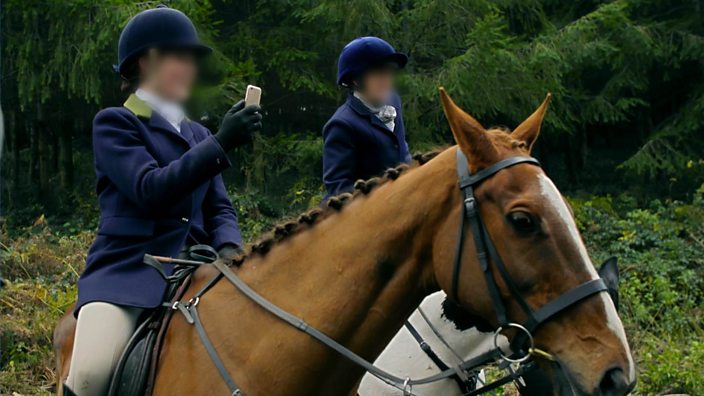 BBC Three
BBC ThreeCathy says she waded through the hounds and gripped the vixen by the scruff of the neck, and with the help of a fellow saboteur bundled it into her car with a jacket over its face.
The feeling of the fox’s teeth breaking the skin of her cheek as she clutched its wet fur tight to her chest was “like loads of pins biting down”.
“When I went back to the hunt the huntsman said: ‘I hope your tetanus is up to date'.”
The vixen survived with the help of a vet. Cathy recovered with the help of a nurse. “I had to sit there with my hands in iodine for 40 minutes and I got a very strong round of antibiotics,” she says.
Hunt saboteurs have existed since the 1960s – but hunt supporters argue that the Hunting Act has made their role redundant because riders have adopted legal methods. The most popular legal alternative – according to the Countryside Alliance – is a ‘trail hunt', in which a runner lays an artificial scent for mounted riders to follow. If a fox is inadvertently killed in the course of such a hunt, it does not mean the hunt is unlawful, however. Indeed, there is no proof the incidents Cathy recounts were deliberate fox kills organised by hunts.
The Countryside Alliance, which supports all forms of legal hunting, says there have been more than 250,000 hunts since the ban – and they claim the overwhelming majority have been lawful. More than 400 people were convicted in the ten years after the Hunting Act came into force, according to Ministry of Justice statistics – but the Countryside Alliance says just 24 of those were involved with “registered" hunts.
“Anti-hunting activists have long campaigned on behalf of animal rights yet their allegations of continuous law-breaking by hunts is completely unfounded,” a spokesperson said.
 BBC Three
BBC ThreeThe earliest known hunt in Britain is thought to have taken place in 16th century Norfolk. It was eventually banned by Labour, under Tony Blair, in 2004. Both subsequent Conservative Prime Ministers have expressed their desire to repeal the ban, promising parliament a free vote on the issue – but both ultimately abandoned the idea.
This may be because the fox hunting ban is thought to be overwhelmingly supported by voters across the political spectrum. A poll by ComRes for the Daily Mirror suggested retaining the fox hunting ban was the most popular policy in Labour’s 2017 general election manifesto, with the support of 78% of the voting-age population (and 64% of Conservative voters).
The saboteurs argue that their attempts to disrupt the hunts is justified by such public support – and the law.
Acquiring the video evidence necessary to prove illegal activity is a risky pastime, however. Interfering with a hunt often requires trespassing on others’ land; a civil offence which gives property owners the right to use 'reasonable force' to eject unwelcome visitors.
Last year a man was cautioned by police after Cathy was left with a bloody cut to her face while trying to film and monitor a hunt in Warwickshire. Video footage shows a man pushing Cathy after she initially refuses to leave his land.
“The guy’s pushing and slapping and sort of whacks me in the face,” says Cathy.
“He said, ‘You can hit me if you want’ – and the answer’s no, I’m not like you. What sort of natural response is that?"
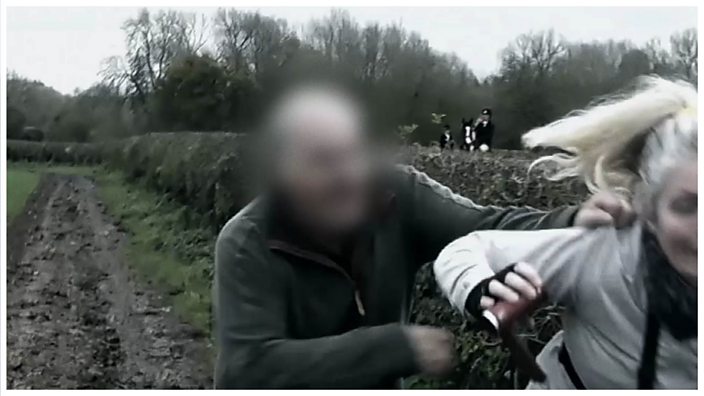 BBC Three
BBC ThreeCathy has also been arrested – “four [or] five times”, she says. She was recently charged with three Public Order offences over a demonstration at a fundraising event for Atherstone hunt. Last month she was found not guilty of all charges.
“It shouldn’t have gone to court in the first place,” she says.
This hasn't dissuaded her from hunt sabotage though – but it does leave her feeling exhausted and in need of some recovery time.
“On a Saturday, when I get in, it’s a beer in a bath,” she says. “It’s not, ‘I’m going to get ready and go out clubbing'.”
Tucked up in her bed, surrounded by fox cushions, ceramics, pictures, and other curios, she says she sleeps sound in the knowledge that she has done all she can to help the lives of animals that she believes society has a “duty of care to protect”.
“There’s something magical about [foxes],” she says. “It’s that lovely sort of slinkiness that they’ve got, and they just sort of glide away. I find them really enchanting.”

